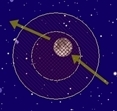- - text and links as of last publication - -
![]()
-------------------
note: due to the source we are using to compute the data of the lunar eclipses, the data therein may be unaccurate. For more accurate data, you may turn to dedicated sites like Fred Espenak's NASA Eclipse Web Site
-------------------
This second, and last Moon eclipse for 2010 is a total Moon eclipse, which will provide the remarkable show of the copper-tinted Moon at the greatest! With the Moon transiting into the North of the Earth's umbra, it's the southern parts of the Moon which will darken the most, with the northern, polar regions likely looking somewhat lighter. A total lunar eclipse if a fine show worth the observation, giving a deep sense of the astronomical scales of the Universe and the large events which may occur there. for more about Moon eclipses, theoretically, see our tutorial: Moon Eclipses
The whole of the eclipse is observable from Alaska and French Polynesia, to the Isthmus of Panama. The regions West of there -down to New Zealand- have the eclipse already en cours by moonrise, as the regions East -down to the coasts of West Africa- have the eclipse interrupted by moonset. The whole of Europe, Africa and Asia, and Australia, don't have any eclipse! The eclipse is beginning by 05:32 UT. The eclipse is unfolding against the confines of constellations Taurus, the Bull and Gemini, the Twins as it is lasting 5h and 31 minute
 |  |  | Those views are showing, from left to right, the regions of the Earth, where the December 21st, 2010 total lunar eclipse is wholly visible, the path of the eclipse through the Earth's penumbra and umbra, and the how the eclipse will look like at its greatest. pictures site 'Amateur Astronomy', based on Celestia (pictures at the far left and the far right) and Cartes du Ciel (picture center) |
The eclipse's main data are the following (data Fred Espenak, NASA/GSFC, undisclosed date). for more about how to observe a lunar eclipse, see our tutorial "Observing a Moon Eclipse":
- umbral magnitude (fraction of Moon's diameter immersed in the umbra at greatest): 1.261
- greatest eclipse: 08:17 UT
- eclipse semi-duration (penumbral): 1h 45m
- eclipse semi-duration (umbral): 1h 14m
- total eclipse duration: 5h 58m